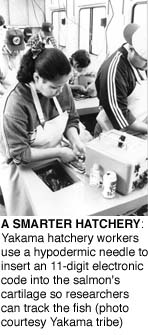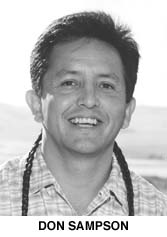forum
library
tutorial
contact

Tribes Blur the Line Between Wild and Hatchery Fish
by Rebecca ClarrenHigh Country News, June 10, 2002
|
the film forum library tutorial contact |

|
Tribes Blur the Line Between Wild and Hatchery Fishby Rebecca ClarrenHigh Country News, June 10, 2002 |
 For a glimpse of how far hatchery reform can go, state and federal agencies need only look at what tribes like the Nez Perce, Umatilla and Yakama are doing with their hatcheries. With money from the Northwest Power Planning Council, a congressionally appointed committee funded by hydropower revenue that aims to mitigate the effects of dams, the tribes are teaching hatchery fish to behave like their wild cousins, by creating holding tanks that resemble wild rivers.
For a glimpse of how far hatchery reform can go, state and federal agencies need only look at what tribes like the Nez Perce, Umatilla and Yakama are doing with their hatcheries. With money from the Northwest Power Planning Council, a congressionally appointed committee funded by hydropower revenue that aims to mitigate the effects of dams, the tribes are teaching hatchery fish to behave like their wild cousins, by creating holding tanks that resemble wild rivers.
Like federal hatcheries, tribal facilities use concrete tanks, but with a slightly different twist, says David Fast, the research manager for the Yakama tribe's fisheries program. At the Yakama hatchery, tanks have sloped floors to create current, and they are painted in a palette of military camouflage. Pigment in the fish's scales responds to the mottled colors, creating a skin tone that allows the fish to blend with stones underwater. The tribes also cover the water's surface with green netting and leaves to provide shade; release feed from the bottom of the tanks to mimic feeding habits in the wild; and periodically introduce predators such as mergansers. With half as many salmon per pool as traditional facilities, the Yakama hatcheries are seeing much less disease.
"It's common sense to try this," says Fast. "We're looking at producing a better quality fish that will survive longer."
 After six years, the Yakama's experiment seems to be working. These "semi-natural" fish returned at a 20 percent higher rate than the traditional hatchery fish produced at the same facility, says Fast.
After six years, the Yakama's experiment seems to be working. These "semi-natural" fish returned at a 20 percent higher rate than the traditional hatchery fish produced at the same facility, says Fast.
The new hatcheries are not only scientifically smart, they are culturally imperative, says Don Sampson, director of the Columbia River Inter-Tribal Fish Commission.
Sampson, a biologist and member of the Umatilla tribe in eastern Oregon, grew up fishing on the Columbia River with his uncles, father and grandfather. They taught him that Indian people and salmon are like brothers, and that, like any relation, he and his offspring have an obligation to protect them "no matter what."
That perspective prompts the tribes to experiment in ways that make some scientists uncomfortable. In traditional hatcheries, fish returning from the ocean swim directly up the rivers and into the hatchery raceways where they were reared. All the fish that aren't needed for spawning, are killed in order to prevent comingling with their wild cousins. Tribal facilities don't spawn fish in the hatchery but in holding tanks that rest within the river, to ensure that when the mature fish return years later, they will spawn their progeny in the wild. In this way, within just one or two generations, fish of hatchery descent will regain the genetics of a wild fish.
 "Hatchery fish and wild fish are the same," says Sampson. "Making a distinction is like saying Indians who went to white boarding schools are different from Indians who stayed on the reservation. People don't realize that fish live in the hatchery for about a year and then spend five years out in the wild."
"Hatchery fish and wild fish are the same," says Sampson. "Making a distinction is like saying Indians who went to white boarding schools are different from Indians who stayed on the reservation. People don't realize that fish live in the hatchery for about a year and then spend five years out in the wild."
But many geneticists worry that allowing hatchery-born fish to spawn in the river with wild populations could dilute the genetic purity of wild fish. They say the hatchery environment selects for fish with certain behavioral traits that may do little to aid survival in the wild. Over time, says Eric Loudenslager, a geneticist at Humboldt (Calif.) State University, those traits lead to a genetic change in the fish that, when mixed with the genes of wild fish, may dilute the highly genetic adaptation that fish hold for specific rivers.
"We don't know enough to take this chance with wild salmon," says Joe Whitworth of Oregon Trout. "When hatchery and wild fish interface, they create offspring that are decreasingly successful. This will further weaken wild runs."
State and federal agencies are following the tribes' efforts, but until this scientific debate is resolved, they will keep most of their hatchery fish returning to concrete tanks.
learn more on topics covered in the film
see the video
read the script
learn the songs
discussion forum
